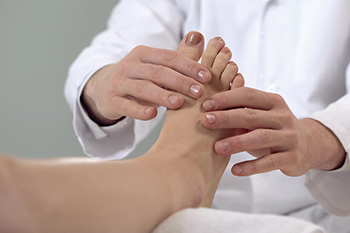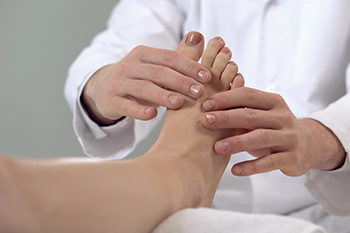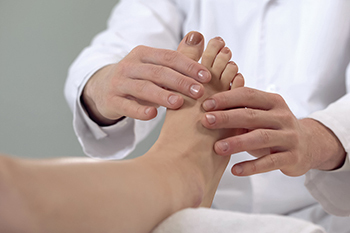Items filtered by date: September 2022
Heel Pain Can Be Treated!
What Is Sever’s Disease?

Sever’s disease is a common overuse injury that affects the heels in growing children. This typically occurs in children ages seven to 14 when their bodies are undergoing rapid growth. Pain may develop due to inflammation where the Achilles tendon inserts into the growth plate located in the heel bone. Activities, like running and jumping can exacerbate the stress on the heel bone’s growth plate and cause pain. As might be expected, this affliction is most often seen in young athletes who participate in sports including soccer, gymnastics, football, and basketball. Such pain often goes away with rest and worsens the activities that caused it. It can be in one or both heels and a child might start limping or walking on their toes to avoid putting pressure on their heels. Resting the affected foot/feet is the best course of action. If the pain does not subside after a short period of time, take your child to a podiatrist who can properly diagnose the condition and treat it appropriately.
Sever's disease often occurs in children and teens. If your child is experiencing foot or ankle pain, see one of our podiatrists from The Sun Healthcare & Surgery Group. Our doctors can treat your child’s foot and ankle needs.
Sever’s Disease
Sever’s disease is also known as calcaneal apophysitis, which is a medical condition that causes heel pain I none or both feet. The disease is known to affect children between the ages of 8 and 14.
Sever’s disease occurs when part of the child’s heel known as the growth plate (calcaneal epiphysis) is attached to the Achilles tendon. This area can suffer injury when the muscles and tendons of the growing foot do not keep pace with bone growth. Therefore, the constant pain which one experiences at the back of the heel will make the child unable to put any weight on the heel. The child is then forced to walk on their toes.
Symptoms
Acute pain – Pain associated with Sever’s disease is usually felt in the heel when the child engages in physical activity such as walking, jumping and or running.
Highly active – Children who are very active are among the most susceptible in experiencing Sever’s disease, because of the stress and tension placed on their feet.
If you have any questions, please feel free to contact our offices located in Antioch, Martinez, and Concord, CA . We offer the newest diagnostic and treatment technologies for all your foot and ankle injuries.
Stretches May Help Before Walking

Research has shown that one of the best things you can do if you have arthritis in your feet is to walk as much as possible. This may cause pain to the feet and ankles, despite being overall beneficial. Performing stretches and exercises may strengthen the feet, possibly reduce arthritis symptoms, and this may be helpful to do before walking. An effective exercise is done by spreading marbles on the floor, followed by sitting on a chair. The marbles are picked up one at a time using the toes, and placed into a cup. Many patients find relief when their foot is placed on top of a tennis ball, and the entire foot is rolled on it. This can be beneficial in strengthening the soles of the feet. There are some patients that notice that as their feet become stronger, their arthritis symptoms may decrease. If you would like information about additional stretches to perform that can help arthritic feet, please confer with a podiatrist.
Arthritis can be a difficult condition to live with. If you are seeking treatment, contact one of our podiatrists from The Sun Healthcare & Surgery Group. Our doctors can provide the care you need to keep you pain-free and on your feet.
Arthritic Foot Care
Arthritis is a joint disorder that involves the inflammation of different joints in your body, such as those in your feet. Arthritis is often caused by a degenerative joint disease and causes mild to severe pain in all affected areas. In addition to this, swelling and stiffness in the affected joints can also be a common symptom of arthritis.
In many cases, wearing ill-fitting shoes can worsen the effects and pain of arthritis. Wearing shoes that have a lower heel and extra room can help your feet feel more comfortable. In cases of rheumatoid arthritis, the arch in your foot may become problematic. Buying shoes with proper arch support that contour to your feet can help immensely.
Alleviating Arthritic Pain
- Exercises that stretch the foot can prevent further pain and injury and increase mobility
- Most of the pain can be alleviated with anti-inflammatory drugs, heat, and topical medications
- Massages can help temporarily alleviate pain.
It is best to see your doctor for the treatment that is right for your needs and symptoms. Conditions vary, and a podiatrist can help you determine the right method of care for your feet.
If you have any questions, please feel free to contact our offices located in Antioch, Martinez, and Concord, CA . We offer the newest diagnostic tools and technology to treat your foot and ankle needs.
Common Symptoms of Sesamoiditis

A foot injury can lead to inflammation and irritation of the sesamoid bones which is known as sesamoiditis. Prompt medical attention is often needed and failure to do so may lead to additional inflammation of the surrounding tendons and ligaments. The pain of this foot condition is often felt in the ball of the foot directly under the joint in the big toe. It can be difficult to walk, and the pain may intensify when the big toe is stretched. Many patients often have a limited range of motion in the big toe, and it may be hard to straighten the toe. Sesamoiditis can occur when the pressure on the ball of the foot is increased, and this may happen from frequently participating in running and jumping activities. Existing foot structures like high arches and bony feet may contribute to sesamoiditis. If you have pain in this part of your foot or exhibit any of the above symptoms, please consult with a podiatrist who can effectively diagnose and treat sesamoiditis.
Sesamoiditis is an unpleasant foot condition characterized by pain in the balls of the feet. If you think you’re struggling with sesamoiditis, contact one of our podiatrists of The Sun Healthcare & Surgery Group. Our doctors will treat your condition thoroughly and effectively.
Sesamoiditis
Sesamoiditis is a condition of the foot that affects the ball of the foot. It is more common in younger people than it is in older people. It can also occur with people who have begun a new exercise program, since their bodies are adjusting to the new physical regimen. Pain may also be caused by the inflammation of tendons surrounding the bones. It is important to seek treatment in its early stages because if you ignore the pain, this condition can lead to more serious problems such as severe irritation and bone fractures.
Causes of Sesamoiditis
- Sudden increase in activity
- Increase in physically strenuous movement without a proper warm up or build up
- Foot structure: those who have smaller, bonier feet or those with a high arch may be more susceptible
Treatment for sesamoiditis is non-invasive and simple. Doctors may recommend a strict rest period where the patient forgoes most physical activity. This will help give the patient time to heal their feet through limited activity. For serious cases, it is best to speak with your doctor to determine a treatment option that will help your specific needs.
If you have any questions please feel free to contact our offices located in Antioch, Martinez, and Concord, CA . We offer the newest diagnostic and treatment technologies for all your foot and ankle needs.
Uncomfortable Plantar Warts

Plantar warts are found on the bottom of the feet, and can be very painful. The majority of warts grow outward, but plantar warts grow inward as a result of standing and walking for most of the day. The medical name for this type of wart is a verruca, and is connected with the human papillomavirus (HPV). The wart appears as a small, thickened area of skin on the bottom of the foot, and many times will have tiny black dots in the center. The virus can enter the body through small cracks in the skin of the feet, and generally lives in warm and moist environments. These can include public swimming pools, shower room floors, and locker rooms. It is advised that appropriate shoes, like flip flops or water shoes, are worn while in these areas. Plantar warts can be extremely uncomfortable, and many patients seek immediate relief. If you are afflicted with a plantar wart, please consult with a podiatrist who can discuss several effective treatment options with you.
Plantar warts can be very uncomfortable. If you need your feet checked, contact one of our podiatrists from The Sun Healthcare & Surgery Group. Our doctors will assist you with all of your foot and ankle needs.
About Plantar Warts
Plantar warts are the result of HPV, or human papillomavirus, getting into open wounds on the feet. They are mostly found on the heels or balls of the feet.
While plantar warts are generally harmless, those experiencing excessive pain or those suffering from diabetes or a compromised immune system require immediate medical care. Plantar warts are easily diagnosed, usually through scraping off a bit of rough skin or by getting a biopsy.
Symptoms
- Lesions on the bottom of your feet, usually rough and grainy
- Hard or thick callused spots
- Wart seeds, which are small clotted blood vessels that look like little black spots
- Pain, discomfort, or tenderness of your feet when walking or standing
Treatment
- Freezing
- Electric tool removal
- Laser Treatment
- Topical Creams (prescription only)
- Over-the-counter medications
To help prevent developing plantar warts, avoid walking barefoot over abrasive surfaces that can cause cuts or wounds for HPV to get into. Avoiding direct contact with other warts, as well as not picking or rubbing existing warts, can help prevent the further spread of plantar warts. However, if you think you have developed plantar warts, speak to your podiatrist. He or she can diagnose the warts on your feet and recommend the appropriate treatment options.
If you have any questions please feel free to contact our offices located in Antioch, Martinez, and Concord, CA . We offer the newest diagnostic and treatment technologies for all your foot and ankle needs.

